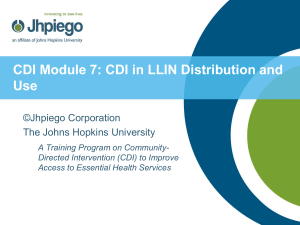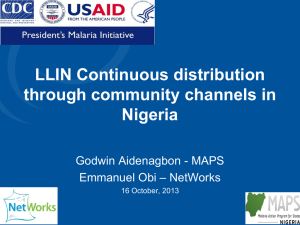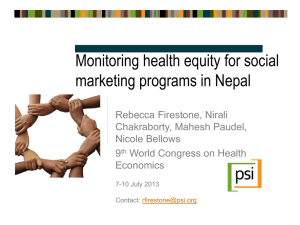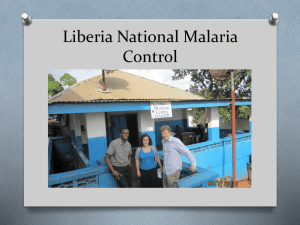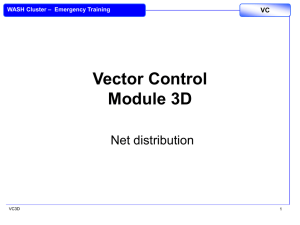Additional file 1
advertisement
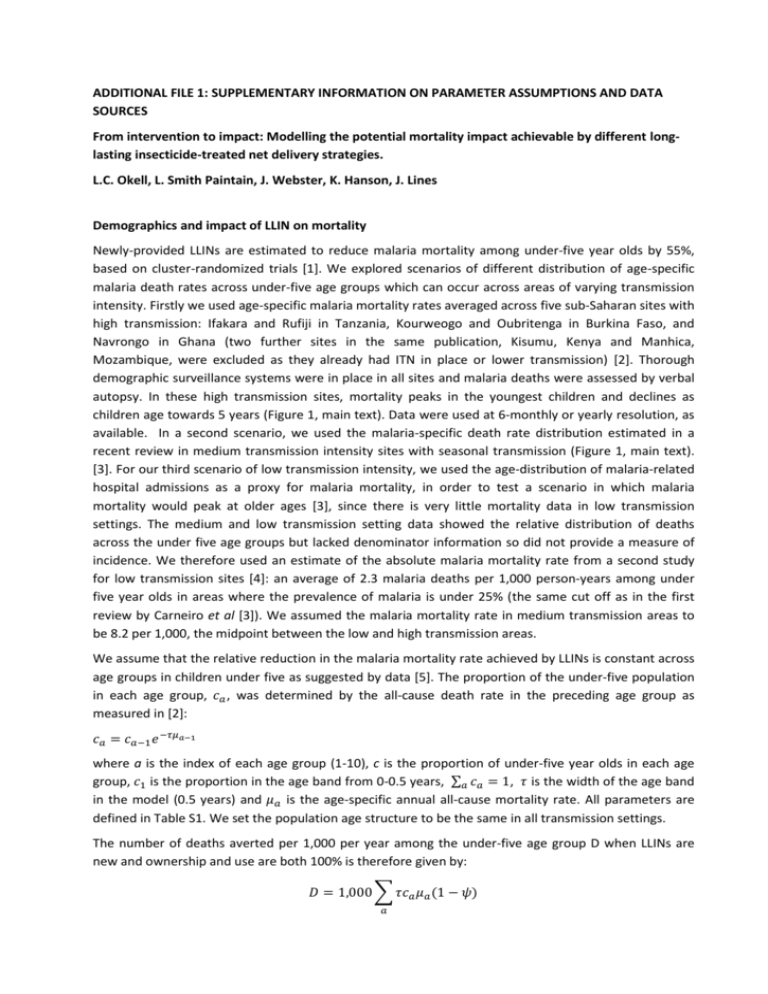
ADDITIONAL FILE 1: SUPPLEMENTARY INFORMATION ON PARAMETER ASSUMPTIONS AND DATA SOURCES From intervention to impact: Modelling the potential mortality impact achievable by different longlasting insecticide-treated net delivery strategies. L.C. Okell, L. Smith Paintain, J. Webster, K. Hanson, J. Lines Demographics and impact of LLIN on mortality Newly-provided LLINs are estimated to reduce malaria mortality among under-five year olds by 55%, based on cluster-randomized trials [1]. We explored scenarios of different distribution of age-specific malaria death rates across under-five age groups which can occur across areas of varying transmission intensity. Firstly we used age-specific malaria mortality rates averaged across five sub-Saharan sites with high transmission: Ifakara and Rufiji in Tanzania, Kourweogo and Oubritenga in Burkina Faso, and Navrongo in Ghana (two further sites in the same publication, Kisumu, Kenya and Manhica, Mozambique, were excluded as they already had ITN in place or lower transmission) [2]. Thorough demographic surveillance systems were in place in all sites and malaria deaths were assessed by verbal autopsy. In these high transmission sites, mortality peaks in the youngest children and declines as children age towards 5 years (Figure 1, main text). Data were used at 6-monthly or yearly resolution, as available. In a second scenario, we used the malaria-specific death rate distribution estimated in a recent review in medium transmission intensity sites with seasonal transmission (Figure 1, main text). [3]. For our third scenario of low transmission intensity, we used the age-distribution of malaria-related hospital admissions as a proxy for malaria mortality, in order to test a scenario in which malaria mortality would peak at older ages [3], since there is very little mortality data in low transmission settings. The medium and low transmission setting data showed the relative distribution of deaths across the under five age groups but lacked denominator information so did not provide a measure of incidence. We therefore used an estimate of the absolute malaria mortality rate from a second study for low transmission sites [4]: an average of 2.3 malaria deaths per 1,000 person-years among under five year olds in areas where the prevalence of malaria is under 25% (the same cut off as in the first review by Carneiro et al [3]). We assumed the malaria mortality rate in medium transmission areas to be 8.2 per 1,000, the midpoint between the low and high transmission areas. We assume that the relative reduction in the malaria mortality rate achieved by LLINs is constant across age groups in children under five as suggested by data [5]. The proportion of the under-five population in each age group, 𝑐𝑎 , was determined by the all-cause death rate in the preceding age group as measured in [2]: 𝑐𝑎 = 𝑐𝑎−1 𝑒 −𝜏𝜇𝑎−1 where a is the index of each age group (1-10), c is the proportion of under-five year olds in each age group, 𝑐1 is the proportion in the age band from 0-0.5 years, ∑𝑎 𝑐𝑎 = 1, 𝜏 is the width of the age band in the model (0.5 years) and 𝜇𝑎 is the age-specific annual all-cause mortality rate. All parameters are defined in Table S1. We set the population age structure to be the same in all transmission settings. The number of deaths averted per 1,000 per year among the under-five age group D when LLINs are new and ownership and use are both 100% is therefore given by: 𝐷 = 1,000 ∑ 𝜏𝑐𝑎 𝜇𝑎 (1 − 𝜓) 𝑎 where 𝜓 is the malaria mortality rate ratio among LLIN users compared to non-users. Table S1: Summary of model parameters, values and variables Parameter 𝜇 Description Value in literature Value(s) used in model 2.3 [4] 14.1 [2] See Figure 1 [2-3] - 2.3 8.2 14.1 See Figure 1 𝜇𝑎 Annual malaria mortality rate per 1,000 children under five years old Low transmission Medium transmission High transmission Annual malaria mortality rate in age group a per 1,000 𝑐𝑎 Proportion of the under-five population in age group a 𝜓 Malaria mortality rate ratio of LLIN user: non-user when the LLIN is new Width of age bands, years Average age of child in years when mother starts using LLIN delivered by ANC Average age of child in years when attending EPI Correlation coefficient of ANC and EPI combined coverage Relative efficacy of an LLIN of age s years, compared to a new LLIN Probability of using an LLIN, stratified by household structure and number of LLIN owned Parameter controlling rate of decay of LLIN efficacy Probability of discarding LLIN during a 6–month period Proportion of malaria deaths averted among non-users of LLIN due to mass effect Maximum reduction in mortality among non-users of LLIN due to mass effect as a proportion of the reduction among LLIN users (1- ) [1] Calculated from death rates 𝜇𝑎 0.45 [6] 0.5 0 [7] DHS surveys (Table S2) [8] 0.5 0.51 TNVS data (Table S4) [9] - 4 0.114 0 to 0.55 dependent on f 0, 1 Parameter controlling the rate of increase of mass effect as LLIN coverage increases - 4 - - - - - - - - - - 𝜏 wA wE 𝜌𝐴𝐸 𝜎𝑠 𝛾 m k q f 𝛽 Model variable t D 𝜒𝐴 , 𝜒𝐸 , 𝜒𝑇 , 𝜒𝑈 a s 𝑦𝑇 , 𝑦𝑈 𝑝𝐴 (𝑎), (𝑎), 𝑝𝐸 𝑝𝑇 (𝑎) 𝑝𝑈 Time in years Deaths averted in all under fives per 1,000 per year Coverage of ANC, EPI, targeted campaigns or universal distribution campaigns, respectively (proportion who receive a net) Age group (indexed 1-10, representing six month age bands from age 0-5 years) Age of LLIN, years Year in which the most recent targeted campaign or universal campaign respectively, was carried out Probability of a child of age a owning an LLIN which was obtained from ANC, EPI or targeted campaigns, respectively Probability of a household owning LLIN from a universal campaign See text Calculating LLIN ownership of LLINs targeted to children under five years We calculated the probability of a single under-five (U5) child having received 0, 1 or 2+ LLINs due to the individual strategies which deliver one LLIN per U5 child (ANC, EPI and targeted campaigns, denoted by subscripts A, E and T, respectively) as follows. Coverage is defined as receipt of an LLIN, therefore incorporating attendance, offer and acceptance. Firstly we considered ownership of LLIN received from each delivery route separately. The probability of an U5 child in age group a owning an LLIN which had been delivered by ANC, 𝑝𝐴 (𝑎), when coverage of ANC is constant over time is: 𝑝𝐴 (𝑎) = 0 where 𝑎 < 𝑤𝐴 𝑝𝐴 (𝑎) = 𝜒𝐴 where 𝑎 = 𝑤𝐴 𝑝𝐴 (𝑎) = 𝑝𝐴 (𝑎 − 1)(1 − 𝑘) where 𝑎 > 𝑤𝐴 where 𝜒𝐴 is the coverage of ANC, wA is the age group of the child when mothers attend ANC, k is the probability of discarding the LLIN in each six month time step and 𝑝𝐴 (𝑎 − 1) denotes the probability of LLIN ownership in the previous six month age band. The probability of an U5 child in age group a owning an LLIN due to EPI is calculated exactly as for ANC, with the A subscript replaced E to denote the EPIspecific coverage and age of delivery. The probability of an U5 child owning an LLIN at time t obtained from each single, targeted campaign is: 𝑝𝑇 (𝑡) = 0 where 𝑡 − 𝑦𝑇 > 5 𝑝𝑇 (𝑡) = 𝜒𝑇 (𝑡) where 𝑡 = 𝑦𝑇 𝑝𝑇 (𝑡) = 𝑝𝑇 (𝑡 − 0.5)(1 − 𝑘) where 𝑡 > 𝑦𝑇 and 𝑡 − 𝑦𝑇 > 5 where 𝜒𝑇 (𝑡) is the coverage of the targeted campaign at time t and 𝑦𝑇 is the year in which the last campaign was carried out. We assumed that the average useful LLIN lifespan was 3 years, and that in all cases the net was discarded a maximum of 5 years after delivery, which is broadly in line with field observations although there are variations between areas. The probability of LLINs being thrown away was set at 0.114 per 6month time step to achieve the average lifespan of 3 years. Benefits of LLINs to children who age out of the under-five age group while still possessing an LLIN are not quantified in this analysis. Secondly we calculated the age- and time-specific probabilities of a U5 child having received and still retaining 0, 1, or 2+ LLINs through combined effects of ANC, EPI and targeted campaigns. A simplified probability tree of this process is shown in Figure S1. The probability of a child in each age band and in each year having received the number of LLINs indicated through a given combination of delivery channels is obtained simply by multiplication across the appropriate branches of the probability tree. The analysis was also stratified by the age of the net (see below). We did not track numbers of LLINs owned greater than 2 since LLIN use was found to be almost identical among those owning 2 LLINs as those owning 3+ LLINs (Table S4) [10]. We assumed that each child would receive no more than two LLINs via targeted campaigns during their first five years of life, based on the recommended 3-yearly frequency. When combining ANC and EPI coverage we included the fact that general level of access to healthcare of each individual would lead to a greater overlap in coverage than expected if coverage of each intervention were independent of the other. Based on data from recent Demographic and Health Surveys conducted in sub-Saharan Africa (Table S2) the median correlation between coverage between the two interventions is 0.51. A correlation coefficient of zero would represent random coverage of each intervention irrespective of the other, for example if ANC coverage was 0.8 and EPI coverage was 0.5, the probability of an individual attending both interventions would be 0.8 x 0.5 = 0.4. A correlation coefficient of 1 would indicate that the same people received both interventions, so in this example all those individuals receiving EPI would also receive ANC (a proportion of 0.5 of the population). The probability of receiving both interventions p AE , given this correlation, was calculated as: p AE 2 1 ( p A ), 1 ( pE ), AE where 2 x, y, AE is the probability that X x and Y y when X and Y have a bivariate normal distribution, with zero means, standard deviations of 1 and correlation AE [11]. Table S2: Summary of Demographic and Health Survey (DHS) data on ANC and EPI attendance and overlap in their coverage. Combinations of ANC and EPI attendance relate to the most recent pregnancy and youngest child, respectively; ANC attendance is defined as woman attended ANC at least once in the most recent pregnancy; EPI coverage is defined as child aged 12-23 months received DPT1, as a proxy for attending EPI at least once [12]. Country & year of survey % women attending ANC at least once Median timing of first ANC visit (months) % children aged 12-23 months receiving DPT1 % attend both ANC & EPI Correlation coefficient between ANC & EPI attendance AE Benin, 2006 Cameroon, 2004 Chad, 2004 Congo, 2005 Ethiopia, 2005 Guinea, 2005 Lesotho, 2004 Liberia, 2007 Madagascar, 2004 Malawi, 2004 Mali, 2006 Namibia, 2007 Niger, 2006 Rwanda, 2005 Senegal, 2005 Zimbabwe, 2006 Median 89.0 83.8 45.3 88.4 28.5 84.9 91.7 97.4 82.8 95.6 75.5 95.8 47.4 95.1 93.8 96.3 88.7 4 4 4 3 5 4 4 3 4 5 4 4 4 6 3 5 4.0 83.9 82.5 44.4 86 57.4 76.9 93.9 75.2 70.5 94.5 82.5 94.4 58 96.4 93.4 76.4 82.5 79.3 73.4 32.7 79.8 22.6 73.3 86.5 74.1 64.7 91.1 66.5 91.1 38.7 92.8 88.9 74.7 74.4 0.68 0.53 0.72 0.60 0.47 0.80 0.18 0.37 0.61 0.43 0.45 0.40 0.67 0.62 0.49 0.37 0.51 Figure S1: Individual child LLIN ownership: probability tree of an under-five child receiving 0, 1 or ≥2 LLINs via different delivery routes over the first five years of a child’s life. Parameters are as defined in the text above. The number of LLIN owned depending on coverage of ANC, EPI and targeted campaigns are shown after each branch (interventions not restricted to happen in this order). It is assumed that a maximum of 2 targeted campaigns would be carried out during the first five years of a child’s life. The analysis was also stratified by the age of LLIN and it was assumed that LLINs were discarded with a constant probability and none were used longer than 5 years (not shown). EPI ANC 1st targeted campaign pT ≥2 p AE yes 2nd targeted campaign ≥2 1 pT no ≥2 yes 1 Individual child no pA p A p AE yes pT 1 1 pT ≥2 yes no 1 pT 1 pT pT 1 pT pT 1 pT pT 1 pT pT 1 pA pT no pE pAE 1 1 pT no 1 yes 0 no 1 pA ( pE pAE ) ≥2 yes pT 0 yes 1 1 pT no 0 1 pT pT 1 pT pT 1 pT pT 1 pT yes no yes no yes no yes no yes no yes no yes no yes no ≥2 ≥2 ≥2 ≥2 ≥2 ≥2 ≥2 1 ≥2 ≥2 ≥2 1 ≥2 1 1 0 Efficacy of nets All analyses on net ownership were stratified by the age of the net, s (equal to the time since distribution). The decline in efficacy of the LLIN due to a combination of insecticide efficacy and number of holes in the net was incorporated [8]. The protective efficacy of a new net was assumed to have an optimal value (1 − 𝜓) equal to that measured in randomized controlled trials [1]. We calculated relative efficacy 𝜎 over time using a function which resulted in a slow decay initially followed by a more rapid decay, resulting in a relative efficacy of 1 when the net is new and an efficacy close to zero after 5 years, to match observed data. The relative efficacy of a net of age s years is given by 𝜎𝑠 = 1 − 𝑒 −𝑚 (𝑒 0.2𝑚𝑠 − 1) where m is a parameter controlling the rate of decay in efficacy. The number of deaths averted was assumed to decline proportionately with LLIN efficacy. Figure S2: LLIN efficacy over time relative to a new LLIN. Relative efficacy 1 0.8 0.6 0.4 0.2 0 0 2 4 Age of LLIN (years) 6 Household LLIN ownership Although individual U5 children may not receive LLINs through the channels above, we allowed that they may have access to LLINs in their household received either through universal LLIN campaigns or through living with other U5 children who have received LLINs through ANC, EPI or targeted campaigns. For universal LLIN distribution campaigns, we model a scenario where 2 LLINs are delivered per household. Therefore the probability of a household owning 2 LLINs at time t obtained from each single, universal campaign is: 𝑝𝑈 (𝑡) = 0 where 𝑡 − 𝑦𝑈 > 5 𝑝𝑈 (𝑡) = 𝜒𝑈 (𝑡) where 𝑡 = 𝑦𝑈 𝑝𝑈 (𝑡) = 𝑝𝑈 (𝑡 − 0.5)(1 − 𝑘) where 𝑡 > 𝑦𝑈 and 𝑡 − 𝑦𝑈 > 5 where 𝜒𝑈 (𝑡) is the coverage of the universal campaign at time t and 𝑦𝑈 is the year in which the last universal campaign was carried out. We assume that both nets distributed to each household are used concurrently and are equally likely to be discarded at any time. Total LLIN ownership by a household depends in part on the number of U5 children. We stratify households by 0, 1, 2 or 3+ U5 children (Table S3). For households with 3+ U5’s we assume an average of 3 children based on Demographic & Health Survey data for Tanzania in 2004-5 [13], where only 9% of households in the 3+ U5’s category have more than 3 U5 children. These assumptions would not be applicable in areas with a different household structure. We calculated the probabilities of households having received and retaining 0, 1 or 2+ LLINs through universal campaigns and through delivery channels targeting U5 children living in the household. Figure S3 shows a simplified probability tree from the perspective of a child under five, indicating the probability of living in a household which has received 0, 1 or 2+ LLINs which he/she can access in addition to any of their own. Combining results from probability trees in Figures S1 and S3 we obtain the probability of a child being in a household with 0, 1 or 2+ LLINs due to all delivery channels. Individual household structures and the ages of all the children within them are not modeled explicitly, however the probability that the child is in a household containing a given number of other U5 children is known (see below). Household ownership of LLINs is then calculated based on the average U5 child. As before the analysis is stratified by the age of the LLIN, and we assume that LLINs are discarded after 5 years. LLIN use by an U5 child The probability of using an LLIN if one or more is owned, 𝛾, was based on data from Tanzania stratified by household structure (0, 1, 2 or 3+ U5 children in the household) and by LLIN ownership at the household level (0, 1 or 2+ LLIN owned) (Table S4) [10]. We used the household structure recorded in the Tanzanian Demographic & Health Survey 2004-2005 to obtain numbers of U5 children living in households of given sizes (Table S3). The probability of a child belonging to a household of a given structure owning a given number of total LLINs was calculated by combining the child’s LLINs with the household LLINs. We assumed that the newest LLIN in the household was always used [14]. Each child was no more likely to use their own net compared to any other net owned by the household. Table S3: Distribution of households, children under five and the whole population living in each type of household structure (categorised according to number of children aged under-five (U5) per household) (Source: Tanzania DHS survey 2004-5 [13]) No. children under five (U5) in household (HH) HH with zero U5 HH with 1 U5 HH with 2 U5 HH with 3 or more U5 Proportion living with each HH structure Households Children under Whole five population 40.9 0 27.4 30.1 30.1 30.7 20.6 41.2 26.1 8.4 28.8 15.8 Table S4: Proportion of children under five (U5) and whole population sleeping under an LLIN according to household structure and household LLIN ownership (Source: TNVS, Kara Hanson, personal communication). Household (HH) LLIN ownership N (people) Children under five years old HH with 1 net 1804 HH with 2 nets 1376 HH with >=3 nets 937 Whole population HH with 1 net 7777 HH with 2 nets 6162 HH with >=3 nets 5674 All HH % of people sleeping under an LLIN HH with HH with 1 HH with 2 zero U5 U5 U5 HH with 3 or more U5 48.3 72.9 71.7 0 0 0 58.7 77.3 77.4 43.1 74.5 74.3 39.3 62.6 61.2 38.1 64.6 73.3 39.4 68.2 83.0 44.4 67.6 74.4 31.0 64.1 66.2 33.7 47.3 48.8 Figure S3: Household LLIN ownership: probability tree of a child having access to 0, 1 or ≥2 LLINs within their household in addition to any received themselves. Up to 2 universal campaigns in which 2 LLINs are delivered per household may be carried out during the first 5 years of a child’s life. If one or two other under-five children live in the household and have received 0,1 or 2 LLINs via ANC, EPI or targeted campaigns then the probabilities are also multiplied across one or both of the last two sections of the probability tree. The probabilities of these other under-five children owning 0, 1 or ≥2 LLINs are obtained from Figure S1 and are a weighted average over the under-five age group. The analysis was also stratified by the age of LLINs and it was assumed that LLINs were no longer used after 5 years (not shown). If 1 other U5 2nd universal campaign 1st universal campaign 1 pU 0 0 1 2 If 2 other U5 0 1 ≥2 0 0 pU 1 pU ≥2 1 2 0 pU 1 pU ≥2 1 2 ≥2 ≥2 ≥2 ≥2 ≥2 ≥2 ≥2 0 pU ≥2 1 2 ≥2 ≥2 ≥2 0 1 2 0 1 2 0 1 2 0 1 ≥2 1 ≥2 ≥2 ≥2 ≥2 ≥2 0 1 2 0 1 2 0 1 2 ≥2 ≥2 ≥2 ≥2 ≥2 ≥2 ≥2 ≥2 ≥2 0 1 2 0 1 2 0 1 2 ≥2 ≥2 ≥2 ≥2 ≥2 ≥2 ≥2 ≥2 ≥2 0 1 2 0 1 2 0 1 2 ≥2 ≥2 ≥2 ≥2 ≥2 ≥2 ≥2 ≥2 ≥2 Mass effect Increased vector mortality resulting from the presence of LLINs in a community can result in an overall reduction in infectious biting, leading to reduced mortality among individuals not sleeping under an LLIN as well as those directly protected [9, 15]. This ‘mass effect’ has been observed in some trials but was absent in others [16] and therefore we explored different scenarios. The relative reduction in malaria mortality achieved in non users of LLINs due to mass effect was denoted q. The maximum reduction in mortality among non-users of LLINs achieved by the mass effect was described as a proportion f of the reduction estimated to occur among LLIN users 1 − 𝜓. Coverage and use of LLINs in individuals of all ages was simulated based on data on household structure and its influence on LLIN use (Tables S3 & S4). The proportion of households owning 0, 1 or 2+ LLINs was assessed using the probability trees in Figures S1 and S3, calculating coverage according to the number of universal campaigns targeted at a household level and the number of U5 children within the household who may have received targeted nets. This analysis was stratified by the age of the newest net, assuming that everyone in the household uses the newest LLIN. We assumed that only LLINs which are in use would contribute towards a mass effect, which is conservative since unused LLINs which are hung may still cause some vector mortality. Since the relationship between coverage and mass effect is uncertain, three scenarios were explored (Figure S4): 1) A mass effect is seen at low LLIN coverage (as suggested by mathematical models e.g. [9]) 𝑞 = (1 − 𝜓)𝑓𝑒 −𝛽𝜒𝛾 + [1 − (1 − 𝜓)𝑓] where 𝛽 controls the rate of increase of mass effect as coverage increases. 2) There is almost no mass effect until coverage is very high 𝑞 = (1 − 𝜓)𝑓[1 − 𝑒 −𝛽 (𝑒 (1−𝜒𝛾) − 1)] + [1 − (1 − 𝜓)𝑓] 3) No mass effect. We assume that an indirect mass effect contributed a negligible amount to the overall 55% reduction in under-five year old mortality measured in field trials. In these trials most children were users of LLINs and there is no clear evidence for additional protection due to mass effect for a child who is already individually protected by an LLIN [17]. relative malaria mortality (%) Figure S4: Mass effect: different assumptions about the relationship between local LLIN coverage and reduction in mortality among children under five years old who do not slep under an LLIN. Mortality is shown among LLIN non-users and users relative to a scenario with no LLINs. The maximum effect among non-users is assumed to be the same as or less than the 55% reduction in malaria deaths among LLIN users. 100 90 80 70 60 50 40 30 20 10 0 non-users scenario 1 non-users scenario 2 non-users scenario 3 LLIN users 0 20 40 60 80 100 Coverage x Use (%) References 1. Eisele TP, Larsen D, Steketee RW: Protective efficacy of interventions for preventing malaria mortality in children in Plasmodium falciparum endemic areas. Int J Epidemiol 2010, 39 Suppl 1:i88-101. 2. Abdullah S, Adazu K, Masanja H, Diallo D, Hodgson A, Ilboudo-Sanogo E, Nhacolo A, Owusu-Agyei S, Thompson R, Smith T, Binka FN: Patterns of age-specific mortality in children in endemic areas of sub-Saharan Africa. Am J Trop Med Hyg 2007, 77:99-105. 3. Carneiro I, Roca-Feltrer A, Griffin JT, Smith L, Tanner M, Schellenberg JA, Greenwood B, Schellenberg D: Age-patterns of malaria vary with severity, transmission intensity and seasonality in sub-Saharan Africa: a systematic review and pooled analysis. PLoS One 2010, 5:e8988. 4. Rowe AK, Steketee RW: Predictions of the impact of malaria control efforts on allcause child mortality in sub-Saharan Africa. Am J Trop Med Hyg 2007, 77:48-55. 5. Habluetzel A, Diallo DA, Esposito F, Lamizana L, Pagnoni F, Lengeler C, Traore C, Cousens SN: Do insecticide-treated curtains reduce all-cause child mortality in Burkina Faso? Trop Med Int Health 1997, 2:855-862. 6. Marchant T, Hanson K, Nathan R, Mponda H, Bruce J, Jones C, Sedekia Y, Mshinda H, Schellenberg J: Timing of delivery of malaria preventive interventions in pregnancy: 7. 8. 9. 10. 11. 12. 13. 14. 15. 16. 17. results from the Tanzania national voucher programme. J Epidemiol Community Health 2011. Clark A, Sanderson C: Timing of children's vaccinations in 45 low-income and middleincome countries: an analysis of survey data. Lancet 2009, 373:1543-1549. Kilian A, Byamukama W, Pigeon O, Atieli F, Duchon S, Phan C: Long-term field performance of a polyester-based long-lasting insecticidal mosquito net in rural Uganda. Malar J 2008, 7:49. Killeen GF, Smith TA, Ferguson HM, Mshinda H, Abdulla S, Lengeler C, Kachur SP: Preventing childhood malaria in Africa by protecting adults from mosquitoes with insecticide-treated nets. PLoS Med 2007, 4:e229. Hanson K, Marchant T, Nathan R, Mponda H, Jones C, Bruce J, Mshinda H, Schellenberg JA: Household ownership and use of insecticide treated nets among target groups after implementation of a national voucher programme in the United Republic of Tanzania: plausibility study using three annual cross sectional household surveys. BMJ 2009, 339:b2434. Griffin JT, Hollingsworth TD, Okell LC, Churcher TS, White M, Hinsley W, Bousema T, Drakeley CJ, Ferguson NM, Basanez MG, Ghani AC: Reducing Plasmodium falciparum malaria transmission in Africa: a model-based evaluation of intervention strategies. PLoS Med 2010, 7:e1000324. Measure-DHS. Demographic and Health Surveys. http://www.measuredhs.com/ National Bureau of Statistics (Tanzania), ORC Macro: Tanzania Demographic and Health Survey 2004-05. In Book Tanzania Demographic and Health Survey 2004-05 (Editor ed.^eds.). City: National Bureau of Statistics and ORC Macro; 2005. Tsuang A, Lines J, Hanson K: Which family members use the best nets? An analysis of the condition of mosquito nets and their distribution within households in Tanzania. Malar J 2010, 9:211. Binka FN, Indome F, Smith T: Impact of spatial distribution of permethrin-impregnated bed nets on child mortality in rural northern Ghana. Am J Trop Med Hyg 1998, 59:8085. Lengeler C: Insecticide-treated bed nets and curtains for preventing malaria. Cochrane Database Syst Rev 2004:CD000363. Howard SC, Omumbo J, Nevill C, Some ES, Donnelly CA, Snow RW: Evidence for a mass community effect of insecticide-treated bednets on the incidence of malaria on the Kenyan coast. Trans R Soc Trop Med Hyg 2000, 94:357-360.
![Additional File 1. Details of model structure and [R] code. To](http://s3.studylib.net/store/data/006922094_1-d87ff4b5618f233a2fbe62bfa2ef7356-300x300.png)
